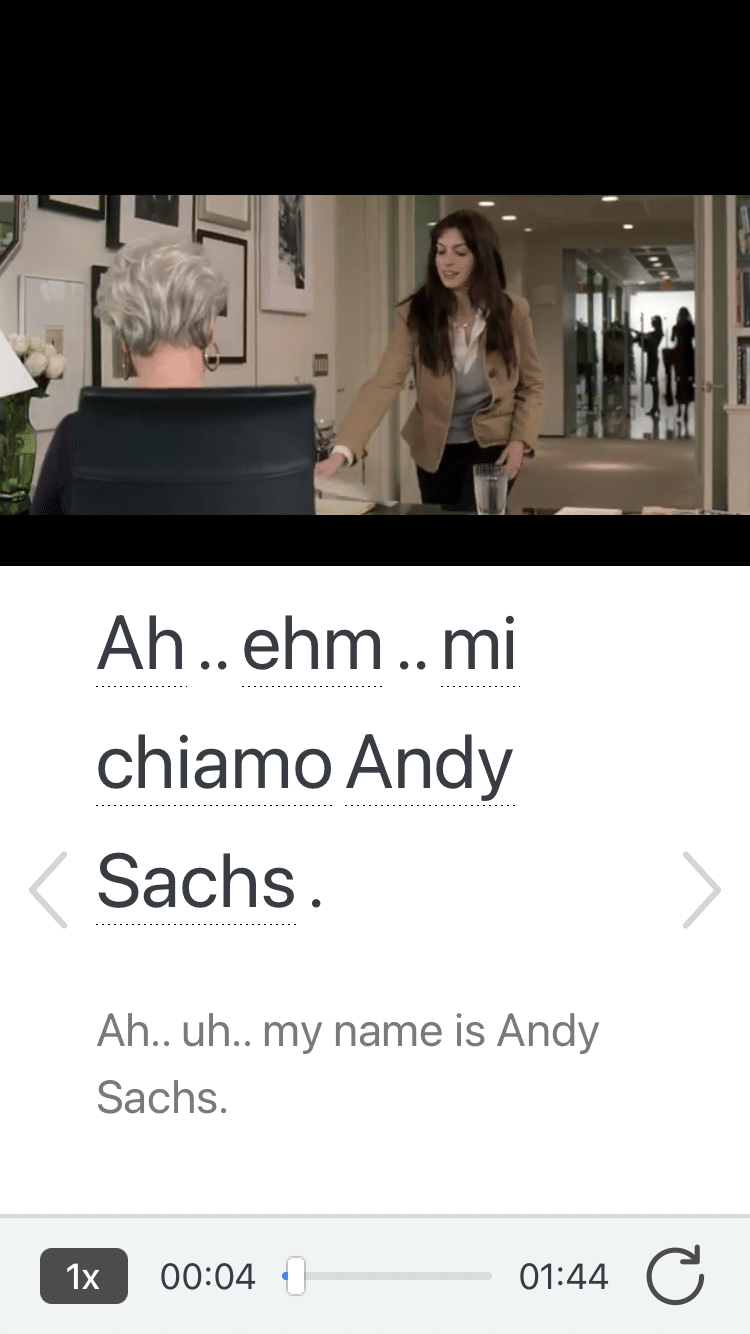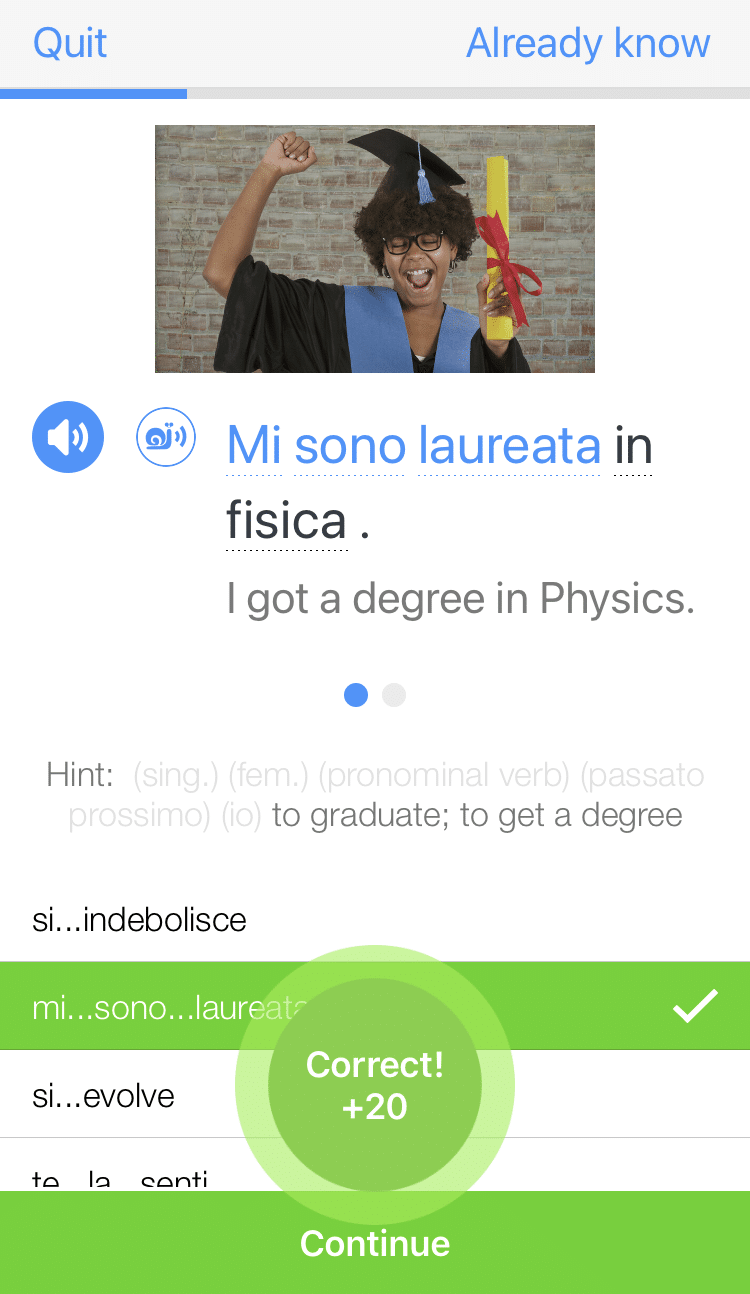
Italian Sentence Structure: How to Master Basic Italian Word Order
The Italian saying “Conosco i miei polli” (“I know my chickens”) really means: “I know what I’m talking about.”
Applied to your language skills, your ability to put Italian vocabulary in proper word order is what indicates that you really know functional Italian.
The basic sentence components—subject, verb and object—must all be present, and the other players—like adverbs and adjectives—have to fall in line in the right ways.
In this post, we’ll cover basic Italian sentence structure and some slight variations to give you a solid foundation of Italian word order.
Contents
- The Basic SVO Sentence Structure
- The VO Sentence Structure
- How to Add Indirect Objects
- How to Add Prepositions
- How to Add Adjectives
- How to Add Adverbs
- Putting It All Together
- How to Combine Simple Sentences
- How to Form Questions
- Where to Practice Forming Sentences in Italian
- And One More Thing...
Download: This blog post is available as a convenient and portable PDF that you can take anywhere. Click here to get a copy. (Download)
The Basic SVO Sentence Structure
So now that we’ve got our chickens assembled, let’s start getting to know them!
In Italian, the general sentence structure is: the subject (who is doing the action), then the verb (the action), then the object (who or what the action is being done to). This is known as SVO word order.
The good news is that English follows the same structure! So if you’re an English speaker, then this isn’t anything new to you.
Let’s consider this example:
Io bevo caffè. (I drink coffee.)
Io (I) is the subject, bevo (drink) is the verb and caffè (coffee) is the object.
Not a big deal, is it? Of course not. You learned how to do this when you learned to speak English.
Note that it’s also very easy to negate these types of simple Italian sentences—simply add the word non (not) before the verb:
Maria non mangia la pizza. (Maria does not eat pizza.)
As you might have noticed, both the subject and the object of an Italian sentence can be either a noun or a pronoun, which brings us to our next point…
The VO Sentence Structure
A pronoun is a word that replaces a noun. They include: I, you, he, she, it, they, etc.
Here’s where we depart from the English similarities: In Italian, you can omit the subject pronoun when the subject is implied by the sentence.
For instance:
Bevo caffè. ([I] drink coffee.)
This isn’t something that you can do in English (“drink coffee” simply becomes a command), but in Italian it’s perfectly normal to omit the subject pronoun.
That’s because we know who’s drinking the coffee based on the conjugation of the verb.
Native Italian speakers rarely use pronouns because the verb endings indicate that information. It’s one way to sound “more Italian” when you speak—just leave off the implied pronouns!
Notice that I said implied. If it’s unclear who’s doing the action (if you’re in a group, for example, or you mentioned multiple subjects), don’t omit the pronoun:
Giuliana beve caffè. (Giuliana drinks coffee.)
Beve caffè. (He/She drinks coffee.)
If we’re drinking coffee with Giuliana, Joe and Vincenzo, we need to keep subjects in place for clarification. Just saying “Beve caffè” doesn’t tell us who’s actually doing the drinking.
In other words, if the pronoun is essential to understanding the sentence, leave it in!
How to Add Indirect Objects
Some verbs in Italian can take an indirect object. A popular example of an Italian verb that takes an indirect object is dare (to give):
Vincenzo da un libro a Maria. (Vincenzo gives a book to Maria.)
Vincenzo (the subject) gives a book (the direct object) to Maria (the indirect object). Once again, this works the same as it does in English.
In Italian, indirect objects are generally introduced with the preposition a (to) and they come after the direct object.
If, however, the direct object is longer than a couple of words, the indirect object can come before it. For example:
Vincenzo da a Maria un libro che ha comprato al negozio. (Vincenzo gave Maria a book that he bought at the store.)
The direct object here (un libro che ha comprato al negozio) is rather complex, so the indirect object must come before it in order to prevent confusion.
How to Add Prepositions
Italian prepositions normally accompany a noun (showing ownership) or a verb (showing direction or location) and come right after that noun or verb:
Ho la penna di Lucrezia. (I have Lucrezia’s pen.)
The preposition di shows that Lucrezia owns la penna.
One complication is that prepositions often combine with the articles that follow them to create contractions.
Andiamo al banco. (We are going to the bank.)
The preposition a (to) combines with the article il (the) to create al (to the), showing us the direction we’re headed.
How to Add Adjectives
Time to move on to adjectives—these words describe or modify nouns, pronouns or other adjectives.
They add a little something extra—a little “oomph” to the spacious, lemon-scented, vibrant chicken coop! (Why is it lemon-scented? Who cares! But it sure gives it character, doesn’t it? That’s the power of adjectives!)
In Italian, there are two things you need to keep in mind:
1. Adjectives follow nouns.
2. Adjectives agree in gender and number with the word they’re modifying.
The second point means that if you’re speaking about multiple chickens, the adjective should reflect this with its ending. Changing adjectives from singular to plural and determining their gender can be done with these general rules:
- If an adjective ends in -a, it is feminine and changes to -e in the plural.
- If an adjective ends in -o, it is masculine and changes to -i in the plural.
- If an adjective ends in -e, it is either feminine or masculine and changes to -i in the plural.
Here are a couple of examples:
- una mucca bianca (a white cow) is singular feminine and becomes mucche bianche (white cows)
- un pollo rosso (a red chicken) is singular masculine and becomes polli rossi (red chickens)
- un maiale nero (a black pig) is singular masculine and becomes maiali neri (black pigs)
Generally, sentences will be constructed using this formula: subject, adjective (describing the subject), verb, object, adjective (describing the object).
Let’s break that down:
Una mucca bianca mangia grano. (A white cow eats grain.)
Una mucca (a cow) is the subject here, while bianca (white) describes it. Mangia (eats) is the verb. Grano (grain) is the object.
Be careful, though! The position of adjectives isn’t totally consistent in Italian. Yes, you heard correctly. Sometimes adjectives can go either before or after a noun.
Let’s introduce a new term: prenominal adjective. This type of adjective comes before the noun and becomes an integral part of its meaning.
Think of the difference as “the noun that is adjective” (adjective after the noun) versus “the adjective noun” (adjective before the noun)—your “friend who is old” is not the same as your “old friend.”
Here’s an example so you’ll get a clear picture of what goes on when you shift adjectives and nouns:
una macchina grande (a big car)
una grande macchina (an expensive, impressive car)
The first example shows the size of the car. The second gives the impression that the car, whatever its size, is impressive.
Other adjectives that go before the noun include:
- piccolo (small)
- buono (good)
- cattivo (bad)
- giovane (young)
- vecchio (old)
- bello (beautiful)
- brutto (ugly)
Keep in mind that all adjectives (those that come before and after nouns) must agree with the gender of the noun they describe.
How to Add Adverbs
An adverb’s function is to answer the question, “how?”
More precisely, how does the subject do whatever action the verb indicates?
In English, you can usually spot an adverb by the ending -ly:
quick → quickly
clumsy → clumsily
sweet → sweetly
How do you make an Italian adverb, then? It’s just as easy! Just add the suffix -mente to the feminine, singular form of an adjective.
Take a look:
veloce (quick) → velocemente (quickly)
goffo (clumsy) → goffamente (clumsily)
dolce (sweet) → dolcemente (sweetly)
In a sentence, the adverb is usually placed after the verb it modifies:
Lui corre rapidamente. (He runs fast.)
Or it’s placed after the verb-object phrase:
Io bevo caffè velocemente. (I drink coffee quickly.)
Adverbs can also be used to modify adjectives. In these cases, the adverb goes before the adjective. Take this sentence, for example:
La birra è molto freddo. (The beer is really cold.)
The adverb molto is modifying the adjective freddo, so it comes before the adjective.
Putting It All Together
When combining each element, the basic Italian word order is as follows:
Subject + [adjective] + verb + [adverb] + [preposition] + object + [preposition] + [indirect object].
Now that you know how basic Italian word order works, here’s a sentence that puts together most of the elements we discussed:
I polli bianchi vanno felicemente all’aia. (White chickens go happily to the barnyard.)
Let’s break it down:
I polli (chickens) — subject
bianchi (white) — adjective
vanno (go) — verb
felicemente (happily) — adverb
all’aia (to the barnyard) — preposition and object
Here’s another sentence that shows a simpler construction:
Le mucche non guidano i trattori. (Cows don’t drive tractors.)
Breaking it down, we get:
Le mucche (cows) — subject
non (not) — negation
guidano (drive) — verb
i trattori (tractors) — object
How to Combine Simple Sentences
As in English, combining multiple sentences in Italian is fairly straightforward. To put two simple sentences together, place a conjunction (a connector word) between the two sentences and take away the middle period.
For example:
Franco studia l’italiano e Giuliana guarda la televisione. (Franco studies Italian and Giuliana watches the TV.)
In this case, the conjunction e is combining two separate sentences to create a longer one.
Other conjunctions include:
- ma (but)
- o (or)
- perché (because)
- quando (when)
How to Form Questions
Of course, we don’t only talk in declarative sentences. The most common spin on the simple Italian sentence is when asking questions.
To ask a simple yes/no question in Italian, simply change the intonation of your voice by raising it at the end of the question, just as you would in English.
For instance:
Hai una matita? (Do you have a pencil?)
On the word matita, your voice should go up to show that you’re asking a question.
To ask an open-ended question, place a question word at the beginning of the question:
Quanto costa? (How much does it cost?)
Notice how the question word is placed before the verb.
Other question words include:
- chi (who)
- che (what)
- che cosa (what)
- dove (where)
- quando (when)
- perché (why)
- come (how)
- quale (which)
Where to Practice Forming Sentences in Italian
Think you’ve got your chickens in order yet? Well, the best way to truly master Italian sentence structure is to practice it!
- You can take this quiz or this quiz to practice unscrambling Italian sentences with the site LearnToFree.
- You can try this exercise of changing positive sentences to negative sentences, or this Q&A exercise, both from the University of Vermont.
Essentially, anything that exposes you to real Italian sentences will help you get better at understanding Italian sentence structure and word order.
Parse sentences and try writing your own with the same structures. You can find sentences in:
This also goes for Italian immersion programs like FluentU.
FluentU takes authentic videos—like music videos, movie trailers, news and inspiring talks—and turns them into personalized language learning lessons.
You can try FluentU for free for 2 weeks. Check out the website or download the iOS app or Android app.
P.S. Click here to take advantage of our current sale! (Expires at the end of this month.)
So, review and remember these rules so you can use them to construct your own Italian sentences.
Then you can leave those chickens in the barnyard or on the plate!
Download: This blog post is available as a convenient and portable PDF that you can take anywhere. Click here to get a copy. (Download)
And One More Thing...
If you're as busy as most of us, you don't always have time for lengthy language lessons. The solution? FluentU!
Learn Italian with funny commericals, documentary excerpts and web series, as you can see here:

FluentU helps you get comfortable with everyday Italian by combining all the benefits of complete immersion and native-level conversations with interactive subtitles. Tap on any word to instantly see an image, in-context definition, example sentences and other videos in which the word is used.

Access a complete interactive transcript of every video under the Dialogue tab, and review words and phrases with convenient audio clips under Vocab.

Once you've watched a video, you can use FluentU's quizzes to actively practice all the vocabulary in that video. Swipe left or right to see more examples of the word you’re on.

FluentU will even keep track of all the Italian words you’re learning, and give you extra practice with difficult words. Plus, it'll tell you exactly when it's time for review. Now that's a 100% personalized experience!
The best part? You can try FluentU for free with a trial.
Start using the FluentU website on your computer or tablet or, better yet, download the FluentU app from the iTunes or Google Play store. Click here to take advantage of our current sale! (Expires at the end of this month.)



